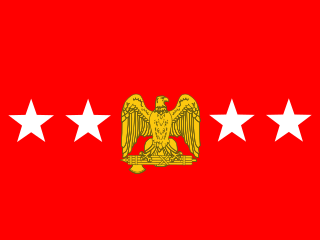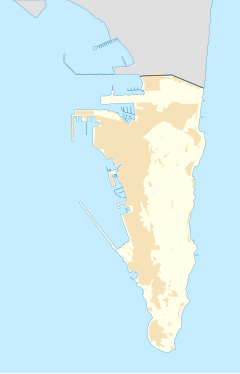
George Dewey was Admiral of the Navy, the only person in United States history to have attained that rank. He is best known for his victory at the Battle of Manila Bay during the Spanish–American War, with the loss of only a single crewman on the American side.

Alfred was sovereign Duke of Saxe-Coburg and Gotha from 1893 to 1900. He was the second son and fourth child of Queen Victoria and Prince Albert. He was known as the Duke of Edinburgh from 1866 until he succeeded his paternal uncle Ernest II as the reigning Duke of Saxe-Coburg and Gotha in the German Empire.

Admiral of the Fleet Richard Howe, 1st Earl Howe,, was a British naval officer. After serving throughout the War of the Austrian Succession, he gained a reputation for his role in amphibious operations against the French coast as part of Britain's policy of naval descents during the Seven Years' War. He also took part, as a naval captain, in the decisive British naval victory at the Battle of Quiberon Bay in November 1759.

Admiral of the Fleet Sir George Rooke was an English naval officer. As a junior officer he saw action at the Battle of Solebay and again at the Battle of Schooneveld during the Third Anglo-Dutch War. As a captain, he conveyed Prince William of Orange to England and took part in the Battle of Bantry Bay during the Williamite War in Ireland.

Prince Luigi Amedeo, Duke of the Abruzzi, was an Italian mountaineer and explorer, briefly Infante of Spain as son of Amadeo I of Spain, member of the royal House of Savoy and cousin of the Italian King Victor Emmanuel III. He is known for his Arctic explorations and for his mountaineering expeditions, particularly to Mount Saint Elias and K2. He also served as an Italian admiral during World War I. He created Villaggio Duca degli Abruzzi in Italian Somalia during his last years of life.

General of the Armies of the United States, more commonly referred to as General of the Armies, is the highest military rank in the United States. The rank has been conferred three times: to John J. Pershing in 1919, as a personal accolade for his command of the American Expeditionary Forces during World War I; to George Washington in 1976, as a posthumous honor during the United States Bicentennial celebrations; and to Ulysses S. Grant in December 2022, when Congress authorized the president to posthumously appoint him to the rank.

The Great Siege of Gibraltar was an unsuccessful attempt by Spain and France to capture Gibraltar from the British during the American Revolutionary War. It was the largest battle in the war by number of combatants.

A five-star rank is the highest military rank in many countries. The rank is that of the most senior operational military commanders, and within NATO's standard rank scale it is designated by the code OF-10. Not all armed forces have such a rank, and in those that do the actual insignia of the five-star ranks may not contain five stars. For example: the insignia for the French OF-10 rank maréchal de France contains seven stars; the insignia for the Portuguese marechal contains four gold stars. The stars used on the various Commonwealth of Nations rank insignias are sometimes colloquially referred to as pips, but in fact either are stars of the orders of the Garter, Thistle or Bath or are Eversleigh stars, depending on the wearer's original regiment or corps, and are used in combination with other heraldic items, such as batons, crowns, swords or maple leaves.

British Forces Gibraltar is the British Armed Forces stationed in the British overseas territory of Gibraltar. Gibraltar is used primarily as a training area, thanks to its good climate and rocky terrain, and as a stopover for aircraft and ships en route to and from deployments East of Suez or in Africa.

Major Eric George Sherbrooke Walker, MC (1887–1976) was a hotelier and founder of the Outspan Hotel and Treetops Hotel in Kenya, as well as a decorated military officer. He is remembered as the host of Queen Elizabeth II and Prince Philip when they visited Treetops in 1952, shortly before receiving news of the death of King George VI and Elizabeth's accession to the throne.
Margaret Emma Faith Irwin was an English historical novelist. She also wrote a factual biography of Sir Walter Raleigh.

Vice-Admiral Kenneth Gilbert Balmain Dewar, CBE was an officer of the Royal Navy. After specialising as a gunnery officer, Dewar became a staff officer and a controversial student of naval tactics before seeing extensive service during the First World War. He served in the Dardanelles Campaign and commanded a monitor in home waters before serving at the Admiralty for more than four years of staff duty. After the war ended he became embroiled in the controversy surrounding the consequences of the Battle of Jutland. Despite this, he held a variety of commands during the 1920s.

Princess Bathildis of Schaumburg-Lippe was daughter of Prince William of Schaumburg-Lippe, and consort of Friedrich, Prince of Waldeck and Pyrmont.

The American War Memorial is a World War I memorial in the British Overseas Territory of Gibraltar. It was built for the American Battle Monuments Commission in 1933, and incorporated into the main city wall, the Line Wall Curtain. It commemorated the successful alliance of the United States and the United Kingdom in their naval exploits in the vicinity of Gibraltar during the Great War. The monument was inaugurated in 1937. Sixty-one years later, in November 1998, the monument was the site of another unveiling ceremony, that of a bronze plaque which commemorated the World War II Allied invasion of North Africa, Operation Torch. That unveiling ceremony was one of a number of events that weekend whose guests included dignitaries from the United Kingdom and the United States.

The Rock Hotel, also known as Rock Hotel, is a historic hotel in the British Overseas Territory of Gibraltar. It has been described as "one of the Mediterranean's most famous hotels," and as "an institution in Gibraltar and the Mediterranean." Built in 1932 by John Crichton-Stuart, 4th Marquess of Bute, the hotel is set in a 3.6-hectare (8.9-acre) landscaped garden and contains 104 rooms. It is located in a large white Art Deco building along Europa Road, overlooking the Gibraltar Botanic Gardens.

The Royal Calpe Hunt of the British Crown Colony of Gibraltar originated in 1812 as the Civil Hunt. The fox hunt was initially a civilian endeavour that began when a pair of English foxhounds were imported to Gibraltar. The hunts took place across the border, in the Campo de Gibraltar area of Spain. However, in 1814, the membership of the Hunt underwent a substantial change. Many officers of the Gibraltar garrison joined the Hunt, which shifted from a civilian to a military enterprise. That year, the name was changed to the Civil Calpe Hunt. It retained that title until 1817, after which it was known as the Calpe Hunt. The first Master of the Hunt was Charles Elphinstone Fleeming. However, the Master most associated with the Hunt was Pablo Larios, Marquis of Marzales, who held that title for forty-five years. His election to that position in 1891 was not only historic, but strategic. His appointment represented only the second time that the position had not been filled by a member of the military. In addition, his Spanish heritage and influence in the Campo de Gibraltar, where he owned extensive estates, garnered him the loyalty of the local Spanish farmers, and therefore eased the ever-present tensions between the military and the farmers over the crop damage that was inherent to the Hunt. In 1906, King Edward VII of the United Kingdom and King Alfonso XIII of Spain became joint Patrons of the Hunt, after which it was known as the Royal Calpe Hunt. The tradition of the Hunt continued for more than a century, until 1939, and the onset of the Second World War

Streets in the British Overseas Territory of Gibraltar are represented by road signs as in the United Kingdom. As of 2007, Gibraltar has a network of 29 kilometres (18 mi) of roads.

Princess Royal's Battery is an artillery battery in the British Overseas Territory of Gibraltar. It is located on Willis's Plateau at the northern end of the Upper Rock Nature Reserve, just southeast of Princess Anne's Battery. Formerly known as Willis' Battery, and later, Queen Anne's Battery or Queen's Battery, it was renamed in the late 18th century after Charlotte, Princess Royal, the eldest daughter of George III. The battery was active from the early 18th century until at least the mid-20th century. However, it has been decommissioned and guns are no longer present. Princess Royal's Battery is listed with the Gibraltar Heritage Trust.

Gibraltar Rock is a granite outcrop in the Porongurup National Park, south of Perth, in Western Australia. From the rock, which is 640 metres high, Albany and the Great Southern Ocean can be seen. Since the 1970s, the Rock, along with some other local peaks, has become a popular venue for rock climbers.
"Admiral Dewey March" is patriotic war march written in 1898 with numerous composers. The march is dedicated to George Dewey, a U.S. Navy Admiral, and his actions during the Spanish–American War, specifically the Battle of Manila Bay in 1898.



























